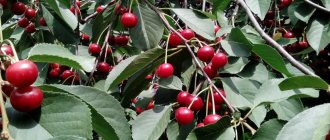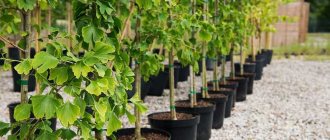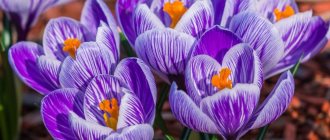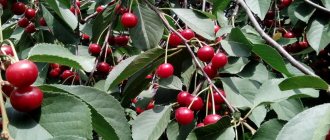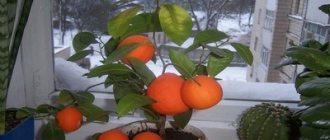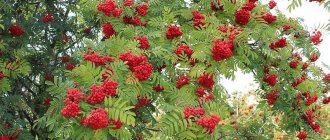Appearance and description
The tree and berries have a fairly simple and brief description:
- A stone fruit tree, notably consisting of a large amount of foliage, a strong trunk and small fruits. Each season it sheds the ovaries and the entire leaf crown.
- The berry has a bright red color and 1 dark seed. Overripe cherries turn dark burgundy.
- The beginning of the family tree is considered to be Plum.
- Life years from 25 to 35 years.
- Resistant to severe frosts and hot summers.
- Tolerant to drought, does not require frequent watering.
- Loves sunlight.
Trimming
Weakened plants are not pruned, because their wounds heal poorly. Only strong, healthy ones can be pruned, mainly forming a bush and canopy crown for common cherries, placing branches at intervals of 5-12 cm.
Excess shoots are removed. Pruning is carried out only in the spring, when the air temperature has a steady transition from 0°C to warming. Damaged branches are pruned later, when they are clearly visible; drying branches must be pruned above actively growing shoots. The cut area is covered with garden varnish.
The crown begins to form in the 3rd year and ends in the 4th-5th year. In a grafted plant, 5-8 closely spaced skeletal branches are formed, in a coppiced plant - 3-6, up to 8 stems. As plants age, they rejuvenate. To do this, new stems are grown from the root shoots, and old ones are removed. Throughout the life of the grafted bushes, all emerging root shoots are removed.
Bloom
It occurs in mid-spring and lasts for a month. The plant also produces spectacular blooms in the form of white flowers. In spring you can experience a beautiful view and a bright aroma.
The smell of the buds is so strong that it can spread over a large number of meters. Even bees can smell pollen from a distance, which allows them to pollinate all neighboring trees and collect honey.
Once a year the gardens bloom, or like cherry blossoms
In many countries, the cherry orchard is a symbol of family, prosperity and native land. And cherry blossoms often represent the bride with her innocence and purity. A tree dressed in a snow-white blanket in April or May evokes admiration and a desire to admire this delicate beauty. And cherry blossoms, which have become one of the symbols of Japan, give rise to a new life cycle.
How cherry blossoms
Sung by poets, cherry belongs to the rose family. The most common type is the common cherry.
Its white flowers are collected in umbrella-shaped inflorescences.
What color are cherry blossoms?
The cherry flower is actinomorphic, i.e. having at least two planes of symmetry dividing it into two equal halves, with a double perianth. It consists of five non-fused sepals; there are also five petals, they are free; stamens 15–20; one pistil is a characteristic feature of the plum subfamily; superior ovary. The common cherry is pollinated by insects.
Recent Entries
Lilac perennials that are beautiful, compact and do not crowd out other plants Why when buying seedlings you should not take the sellers’ word for it and how to determine the age of the plant using 3 signs Tomato seedlings have turned purple or whitish: why the color has changed and how to save the plants
Cherry blossoms leave no one indifferent
How many days does cherry blossom
Cherry blossoms usually last for 7–10 days, and in cloudy weather they can last up to two weeks.
When cherry blossoms - flowering dates
Cherry blossoms until the vegetative buds bloom, sometimes simultaneously with it. The time when flowering begins depends on the growing zone and specific weather conditions. The beginning of flowering is usually associated with an increase in temperatures up to +100C. Mass flowering begins if average daily temperatures of +100C persist for two weeks. In cool weather it lasts up to two weeks.
According to the timing of flowering, cherries can be divided into early-, mid- and late-blooming.
Cherry blossoms and bees need each other
Flowering dates depending on the growing area - table
| Growing area | Flowering time | Peculiarities | Most common varieties |
| Ukraine | End of April - beginning of May | Ukrainian Griot, Lotovka, Early Spanka, Amorel, Large-fruited Spanka, Elegant, Toy | |
| Central Russia | from 7–10 to 15 May | Cherry blossoms often occur during rainy weather. During this period, bees do not fly and do not pollinate flowers. As a result, you may be left without a harvest. The way out of this situation is to plant self-fertile varieties that can be pollinated without the help of insects with their own pollen. | Apukhtinskaya, Youth, Almaz, Chernokorka, Meeting, Lyubskaya, Shokoladnitsa, Fatezh, Chermashnaya, Gift of Ryazan, Iput, Tyutchevka, Early Oryol, Kharitonovskaya, Kursk Spanka, Yubileinnaya, Shubinka |
| Moscow region | from 7–10 to 15 May | It is difficult to obtain a high harvest of cherries in the Moscow region. | Apukhtinskaya, Youth, Diamond, Meeting, Lyubskaya, Shokoladnitsa, Fatezh, Chermashnaya, Gift of Ryazan, Iput, Tyutchevka, Orlovskaya early, Poetry, Baby, Coral, Griot Moscow |
| Krasnodar | End of April - beginning of May | Lyubskaya, Apukhtinskaya, Shpanka, Krasnodar sweet, Novella, Nord-star, Orlitsa | |
| Crimea | April 20–27 | English early, Podbelskaya, Anadolskaya | |
| Kuban | April 20–27 | Lyubskaya, Apukhtinskaya, Shpanka, Krasnodar sweet, Novella, Nord-star, Garland, | |
| Saint Petersburg | End of May - beginning of June | Cold rainy weather prevents the formation of a good harvest. | Vladimirskaya, Rubinovaya, Zvezdochka, Lyubskaya, Shpanka Shimskaya, Rainbow, Zarnitsa, Bagryannaya, Amorel Nikiforova |
| Ural and Siberian regions | End of May - first ten days of June (May 20-25 - early flowering, May 25-30 medium flowering, June 1-5 late flowering) | Middle and late flowering periods are more suitable for the Urals. In this case, they are less at risk of frost. | Maksimovskaya, Mayak, Metelitsa, Zmeinogorskaya, Ashinskaya ordinary, Ob, Malinovka |
| Rostov | Third ten days of April | Lyubskaya, Zhukovskaya, Competitor, Lada, Livenka, Meteor, Kharitonovskaya |
Cherry blossoms - spring, beauty, life - video
When do cherry blossoms bloom? This is far from an idle question. After all, a blooming cherry orchard is not only a beauty to the eye, but also a hope for a successful harvest of your favorite fruits. And if the flowering took place at the right time, and the weather did not disappoint, then the harvest will definitely please both the gardeners themselves and those who simply love aromatic berries.
- Author: Natalya Stepanova
My name is Natalya. By profession I am a teacher of Russian language and literature. Rate this article:
- 5
- 4
- 3
- 2
- 1
(4 votes, average: 3.8 out of 5)
Share with your friends!
The best varieties for planting
The berry has a rich pedigree, and most types of cherries have survived to this day. But only some of the best can be considered suitable for cultivation. Experienced gardeners can grow any species, but beginners should tone down their ardor a little and choose a simpler direction.
Molodezhnaya is an ordinary crossed cherry, between the Vladimir and Lyubskaya berries. Suitable for any soil and garden, thanks to its improved composition and strong shell. The fruits are large, fragrant and juicy, which allows them to be used in any culinary masterpiece.
Turgenevka is resistant to the fungus coccomycosis and copes well with unfavorable habitats. The size of the berries is quite large, and the sugar level is brought to the ideal. Can be grown in any garden.
Chocolate - has quite large and sweet fruits, and the tree reaches 3 meters. Unfortunately, the plant is inferior in terms of resistance to fungal growth. It needs to be treated and treated frequently.
Lyubskaya is an incredibly wide tree that grows more than 2 meters. The advantages of “lyubskaya” can be considered an increased level of benefits and vitamins that the human body needs so much.
Cherry care
A cherry bush or tree requires proper attention in all aspects. The first few years it does not need to be fertilized, but it should be protected from climate change. When a small tree turns into a wide and noble tree, it must be properly taken care of: watered, fertilized, pruned.
Unlike many plants, cherries need frequent watering. Until it bears fruit - once every 2 weeks, in hot weather - once every 6 days. When ripe fruits begin to appear - once every 3 days, two buckets per object.
The stone fruit plant needs to be flavored and “fed”, in this way rotting and the appearance of worms can be avoided. The optimal organic feed is a mixture of superphosphate and sulfate, which is injected directly into the ground.
In addition to constant actions, it is important to treat the vegetation and carry out annual pruning of the crown. If the cherry variety is susceptible to fungus, then all organs of the plant should be treated with a urea solution. This mixture will “kill” all pests under the bark.
Planting material: preparation secrets
The most favorable time for planting cherries is autumn. This applies to harvesting shoots and rooting. When selecting planting material yourself, you should separate several green shoots located on the southern part of the tree. Cuttings are cut from them, having at least 4 leaves, approximately 12 cm long.
Harvested seedlings are placed in a container with soil at a distance of 6-7 cm from each other. Creating a “greenhouse effect” will significantly speed up the rooting process. To do this, the box with the planted cuttings is covered with polyethylene. Until spring, seedlings should be provided with conditions for wintering: buried, covered with spruce branches.
When choosing ready-made trees as planting material, you should pay attention to two-year-old seedlings. The parameters of such plants are as follows:
- 55–60 cm - height;
- 56–60 cm — length of skeletal shoots;
- 2 cm is the diameter of the tree.
Such seedlings are most suitable for autumn planting for wintering. It is recommended to place trees in open ground in the spring.
Application
Domestic and even wild cherries can provide benefits with their external body parts. Thanks to the leaves, inflammatory processes can be stopped or slowed down. To do this, you need to dry and grind the leaves, and then brew them as a fortified tea.
It should be remembered that bones are completely dangerous, but in small quantities they can affect the treatment of gout. 1-2 bones per week and the disease remains the same.
- Plot near a pond: nuances of choice
- Which fast-growing shrubs are suitable for green fences?
- Juniper stricta - description, cultivation, planting and care. Secrets of garden maintenance and application in landscape design (130 photos and videos)
Who doesn't like to eat delicious food? Probably someone who has never tried ripe cherries. It is used in making excellent pies, drinks and dumplings. All dishes are so reminiscent of childhood that adult life is accompanied by an eternal search for the right berries.
Chemical composition
The common cherry is rich in many different natural substances - the bark, leaves and fruits are unique in their own way. Consider in more detail each component for the presence of chemicals and their significance for humans:
- Leaves and green branches. There are such elements as: vitamins, acids of organic origin, carbohydrates, trace elements, essential oils, coumarin and tannins. In the right proportions, all these substances have a beneficial effect on the body, improving the functioning of a wide variety of systems;
- Wood (including bark). The content of coumarin and oxycoumarin, anti-rot (disinfecting) substances and various essential oils has a protective effect on the tree against various pests. The same properties appear on the human body;
- Fresh fruits. It contains the widest list of elements necessary for human health, namely: vitamins (C, A, B1-2-3, etc.), antioxidants, pectins, organic acids (salicylic, malic, citric, etc.), carbohydrates, micro - and macroelements, coumarin, anthocyanins (natural coloring substances).
- Bones. Their composition is as follows: oils, amygdalase. It should be noted that the bone itself contains the poison amygdalin (later cyanide) - the content in one unit will not affect a person in any way - the body is able to neutralize it.
The least studied part of the cherry is the stalk.
The already familiar substance tannin, some natural dyes, etc. are present here.
Cherry fruit
Bark of tree
Common cherry leaves
Active ingredients
This garden representative has a huge number of active substances that activate many processes, both in its composition and in the composition of other organisms.
The presence of sugars (mainly glucose) and acids (nicotinic, folic, etc.), as well as the presence of carotene, has a positive effect on all metabolic processes. And vitamins P, C, B1 and B2 contained in the pulp also form an active complex.
Red shades of varying degrees of ripeness are due to anthocyanins and bioflavonoids. The leaves act as raw materials for collecting rutin, or vitamin P.
As for tannins, there is very little of it - just over 0.2%, pectin contains -0.5%.
By the way, the role of pectin is very important when making jam - such jam is candied in very rare cases and practically does not form jelly.
